|
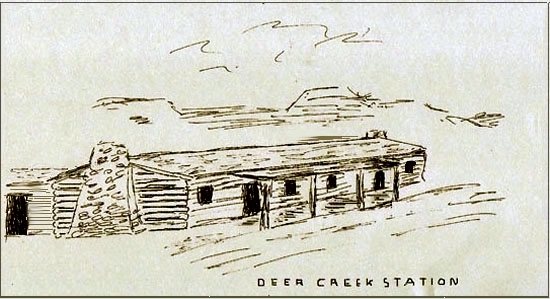
Deer Creek Station, approx. 1860
Glenrock, 26 miles east of Casper, was originally known as Deer Creek Station or Deer Spring.
established at the confluence of Deer Creek and the North Platte in 1857.
The Station was established in 1857 at the confluence of Deer Creek and
the North Platte. In addtion to the stage station there was a blacksmith and post office. Sir
Richard Burton in his 1860 journey also noted the presence of a "grog shop." The saloon was owned by early
mountain man Joseph Bissonette. Bissonette was a member of Manuel Lisa's expedition of
1812-1813 and served as an interpreter for Steven Long's 1819-1820 exploration of parts of
present day Oklahoma, Kansas, Nebraska and Colorado. He also participated for
a short distance for Fremont's first expedition. Later
the Deer Creek Station served as a pony express, telegraph station and as starting point for the
Bozeman Trail. By 1865, the Indians had become restless and there
were frequent problems of the telegraph line being cut and guards killed. In 1866, the
Station was burned.
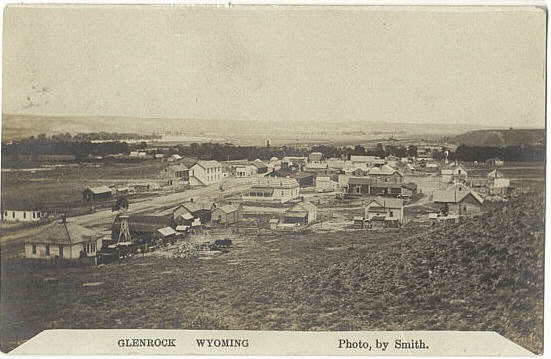
Glenrock, 1909, looking northeast.
Deer Creek is marked by the
line of trees in the above photo. Beyond the trees may be seen the North Platte. Near this
site was constructed one of several bridges constructed by John Richard (Reshaw) in the
1850's. The one near Deer Creek washed away in a flood in 1852. More famous was his
bridge at Evansville near Casper of which Sir Richard Burton commented,
"A wooden bridge was built at this point some years ago at an expense of $26,000 by one Reshaw,
who, if report does not belie him, has gained and lost more fortunes than a Wall Street professional." Many of the
emigrant trains would camp nearby at the "Rock in the Glen.
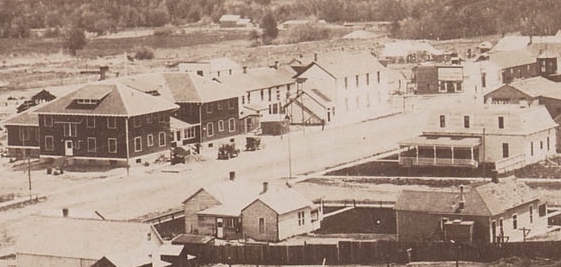
Glenrock, 1916
Compare photo with the first photo above and with next photo. Note new buildings to left of white hotel and the addition
of sidewalks including on the side street in front of the house with
the mansard roof. The
growth was prompted by the discovery of oil in nearby Big Muddy.The new building under construction is the
Hotel Higgens which was constructed by John E. Higgens in 1916.
Nearby, for a time, was the Upper Platte Agency. The agency, originally located at
Fort Bent, was moved to the area in 1855 and was the headquarters for
Major Thomas S. Twiss (1803-1870). Twiss was second in the West Point class of
1826 and was a class-mate of Albert Sidney Johnston. At first, Twiss had a
reputation of being harsh, but following his marriage to Mary Standing Elk (1832-1917), he became
more understanding. As a result, the Lakota gave her the name Wanikiyewin,
"Saves the Tribe." The agency was later moved to Whetstone Creek on the Missouri.
Eugene Ware in his
Indian War of 1864 described meeting Major Twiss at Fort Laramie:
A very strange thing happened one evening at the sutler quarters. Along
about sundown several squaws very finely dressed in mackinaw blankets came
up to the sutler store with an old gentleman whose hair, long, white and
curly, hung down over his shoulders, and down his back. He had a very
venerable white beard and moustache. His beard bad been trimmed with
scissors so that it was rather long, but pointed, Van Dyke fashion, below
the chin. He was dressed thoroughly as an Indian. He wore nothing on his
head, and had on a pair of beaded moccasins. He sat on one of the benches
in front of the sutler store, having in his hand a cane, staff fashion,
about six feet long. Some of the officers were discussing Grant's Vicksburg
campaign, and about the dangerous character of his trip around and below
Vicksburg, and they were analyzing it as a military feat. After listening
a little while this old fellow got up, and got out several feet in front of
the talkers, and said: "Grant did just what Napoleon did." Then, taking his
staff, he began marking in the sand, and said, "At Borodino, Napoleon
started out from here, and he marched around to here," and so on. The old
gentleman went all through the Napoleonic campaign and then went through
the Grant campaign, with all of us looking on silently and listening. He
finished the demonstration at great length, talked very sensibly, and
everybody, whether they knew him or not, paid attention to what he said.
After a while the party broke up, and I asked several present who the
person was; they said they didn't know. Finally I met a man who told me
that this man belonged to a very fine Eastern family. That he was educated
in West Point, had been a Major in the regular army, and made up his mind
years before to become an Indian, and live with the Sioux. That his name
was Major Twiss; was married into the Sioux tribe; came down to Fort
Laramie occasionally, and went back up into the unexplored Indian country,
nobody knew where. The next day I inquired about him further, because I
wanted to see him again, but he had gone out to the squaw camp, and from
there he and his squaws disappeared to the north.
Writer's note: If, indeed, Major Twiss compared Borodino, 7 September 1812, in the Russian Campaign to
Grant before Vicksburg, he misspoke. At Borodino, the Emperor rejected Marshal Davout's advice to
employ a flanking attack, but instead, engaged in a very bloody direct frontal assault in which
the Russians received some 44,000 casualties before retreating and the French 33,000
casualties. Vicksburg fell after Grant out flanked Gen. Pemberton by landing below Vicksburg and then attacking from the
landward side.
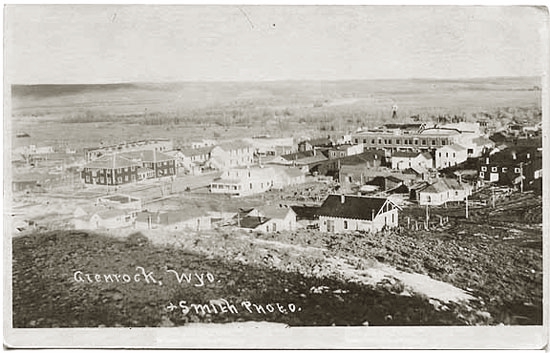
Glenrock, undated, looking northeast.
The hotel has now been restored and is on the National Register of historic places.
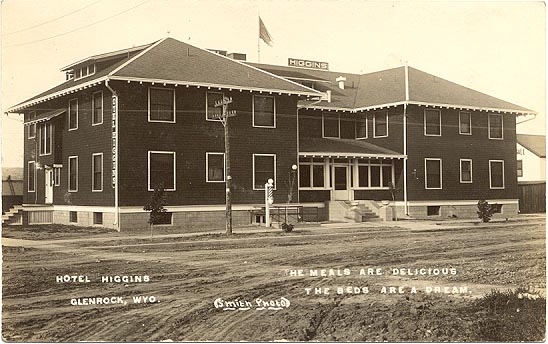
Hotel Higgins, approx. 1916
As indicated above, the Hotel at 416 W. Birch, is still in business.
North Platte Photos continued on next page.
|